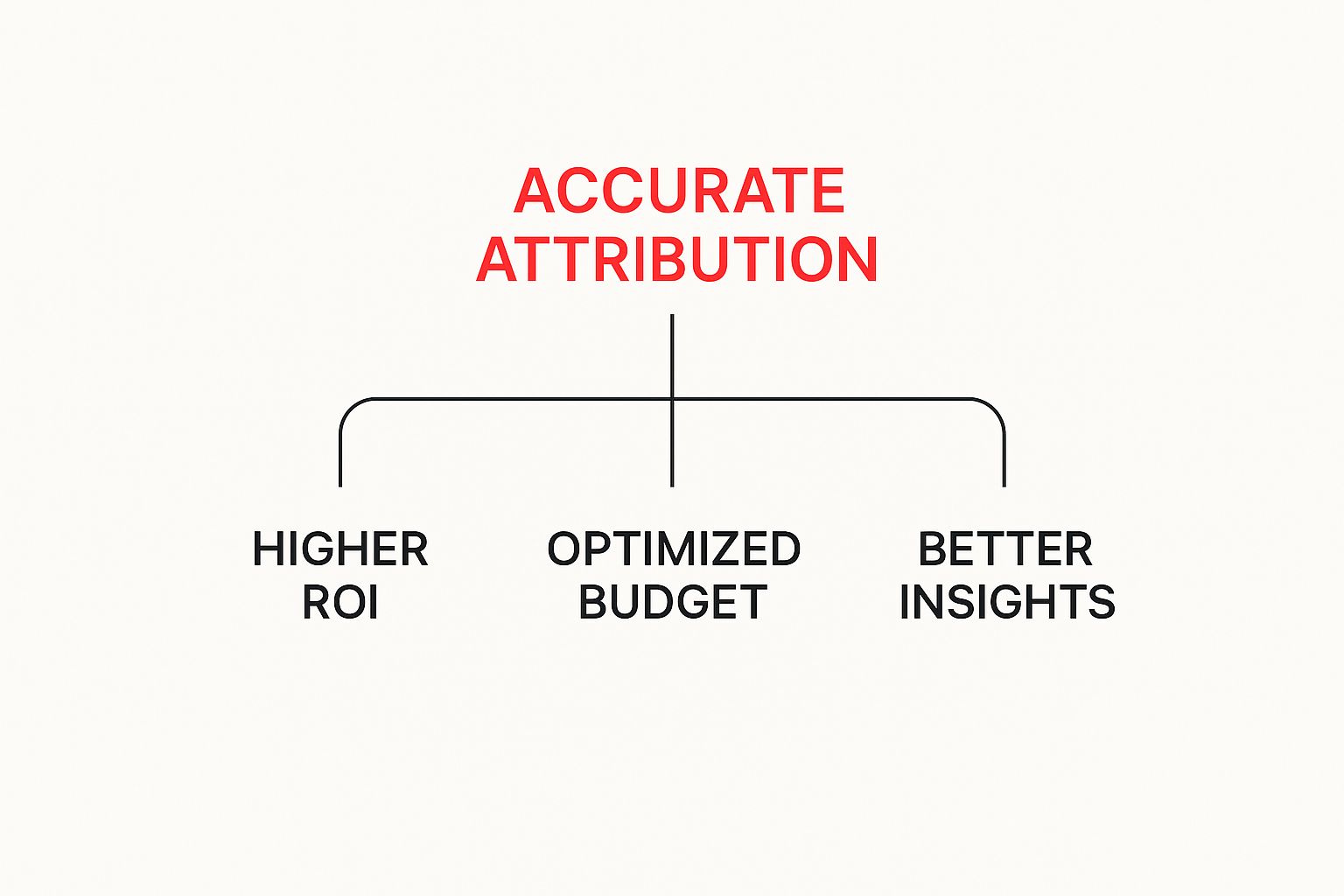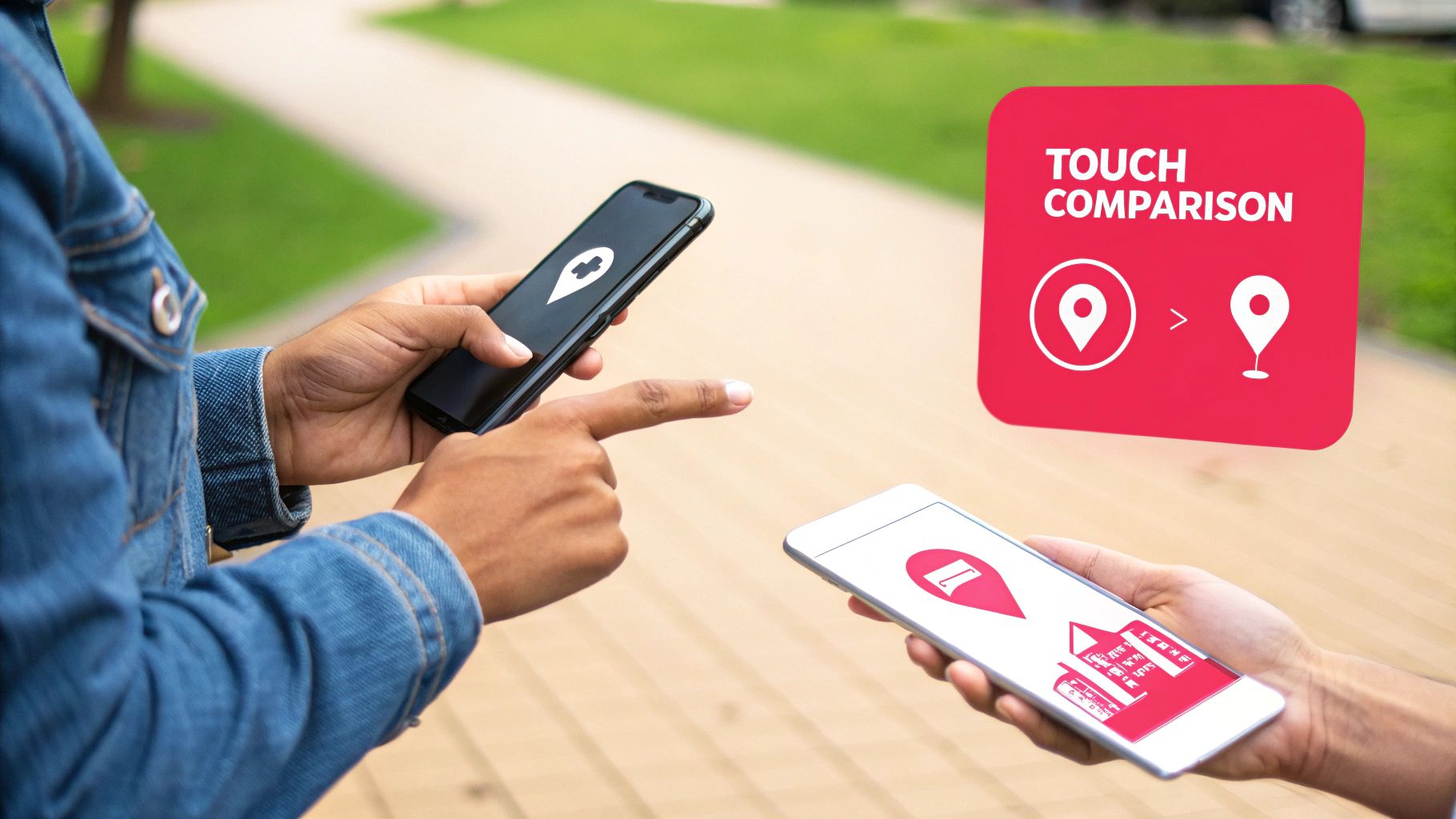 How to Boost Online Sales Fast
How to Boost Online Sales Fast
Multi-channel attribution models are just frameworks for figuring out which of your marketing efforts deserve credit when a customer makes a purchase. It’s a way of looking at the entire customer journey and giving a slice of the credit to the different touchpoints that helped along the way, like social media ads, blog posts, and email campaigns, instead of just giving 100% of the credit to one single interaction.
Table of Contents
Why Your Last Click Tells a Flawed Story

Think of a customer's path to buying from you like a soccer game. They might see an ad on Instagram (that’s a strategic pass downfield), then search for you on Google (a quick dribble), read one of your blog posts (a perfect cross into the box), and finally, get an email that prompts them to buy (the final goal).
If you’re only looking at last-click attribution, you're giving all the glory to the email—the one who scored the goal. Sure, that last shot was critical, but this view completely ignores all the incredible teamwork that made the goal possible in the first place. It misses the smart pass and the skilled setup that were just as vital to the win.
The Problem with a Narrow View
When you rely on a single touchpoint like the last click, you're getting a dangerously incomplete picture of your marketing performance. This tunnel vision often leads to terrible budget decisions because it completely undervalues the channels that build awareness and nurture leads early on.
A last-click model can’t tell the difference between a channel that assisted a conversion and one that did nothing at all. It treats every touchpoint before the last one as worthless, which is almost never the case.
When you only credit that final step, you risk cutting the budget for the very channels that are introducing your brand to new people. This is where multi-channel attribution models become absolutely essential. They’re like the 'game analysis' for your marketing, showing you which players—or channels—made the most valuable moves throughout the entire journey.
By adopting this broader view, you can finally:
- Accurately Measure ROI: Get a real sense of the return on investment for every channel, not just the ones that close the deal.
- Optimize Budget Allocation: Confidently put money into channels that assist conversions, even if they aren't the final touchpoint.
- Improve Customer Insights: Gain a much deeper understanding of how customers actually interact with your brand across different platforms.
This is especially critical when you're trying to figure out how to measure influencer marketing ROI, since influencers often play a huge role in the early awareness and consideration stages. Without a multi-channel view, their massive impact could be completely overlooked.
From Simple Clicks to Winding Customer Journeys
To really get why modern multi-channel attribution models are such a big deal, it helps to rewind the clock a bit. The quest to measure marketing's impact isn't new. It actually goes all the way back to the 1950s with the rise of Media Mix Modeling (MMM). This was the first serious attempt to statistically link ad spend on channels like TV and radio to actual sales.
For decades, that high-level, top-down view was the best we had. Then the internet came along and changed the game completely. As the digital world exploded in the early 2000s, tracking got sharper, and a new, much simpler standard took over: last-click attribution. Suddenly, marketers could draw a straight line from a conversion right back to the very last ad someone clicked.
The Problem with Last-Click
Last-click was easy. It was clean. It gave a straightforward, if ultimately misleading, answer to the question, "What made this person buy?" Because of its simplicity, it became the default for years.
But as channels multiplied—from search and display ads to social media, email, and beyond—the customer's path to purchase became a tangled web.
Imagine this common scenario: A customer sees an ad for a new pair of sneakers on Facebook. A few days later, they search for them on Google. Then, a week after that, they finally click a link in a promotional email to make the purchase.
The last-click model looks at that entire journey and gives 100% of the credit to the email. The Facebook ad that sparked the initial interest? Ignored. The Google search that showed intent? Overlooked. This created a warped reality, making "closing" channels look like heroes while completely undervaluing the channels that do the heavy lifting of building awareness and desire.
Seeing the Bigger Picture
By the mid-2000s, it was painfully obvious that giving all the glory to a single touchpoint just wasn't cutting it. The industry needed a smarter way to think about credit, which paved the way for multi-touch attribution models—methods designed to spread credit across multiple interactions. This wasn't just a technical upgrade; it was a fundamental shift in philosophy.
Marketers finally accepted that a purchase is rarely a single event. It's the result of a series of moments, nudges, and influences, and every single one plays a role. If you only look at the finish line, you're making decisions with half the story.
To map this path correctly, you have to go deep. For instance, properly tracking affiliate links goes beyond simple clicks; it requires a system that can see all the interactions leading up to a conversion. This evolution from just counting clicks to truly analyzing the entire journey is what defines modern marketing measurement.
Comparing The Most Common Attribution Models
Think of different multi channel attribution models like choosing the right camera lens for a photo shoot. Each one captures the customer's journey from a unique angle, bringing certain moments into sharp focus while others fade into the background. Getting a handle on these different perspectives is the first real step toward seeing your marketing performance with total clarity.
This image really drives home how getting attribution right isn't just a reporting task—it's the bedrock for smarter growth, a tighter budget, and better business decisions across the board.

As you can see, accurate measurement is what separates guessing from growing. It's the key to turning data into dollars.
Let's dive into the most common models marketers use, starting with the simplest and working our way up.
Simple Single-Touch Models
The most straightforward models are called "single-touch" for a reason: they give 100% of the credit for a sale to a single marketing interaction. They're incredibly easy to set up and understand, but their laser focus can sometimes give you a skewed picture of reality.
First-Touch Attribution: This model is all about the first impression. It gives all the glory to the very first channel that introduced a customer to your brand. Imagine it as crediting the movie trailer that first piqued your interest, completely ignoring the glowing reviews or TV spots you saw afterward. This one is a go-to for brands laser-focused on top-of-funnel awareness and demand generation.
Last-Touch Attribution: This is the classic default for many platforms, and it's all about the final moments. It assigns all credit to the final touchpoint right before the conversion happens. This is a bit like giving the game-winning trophy only to the player who scored the final goal, overlooking all the teamwork and assists that made the shot possible. It's still useful for figuring out which channels are your best "closers."
Advanced Multi-Touch Models
Of course, the reality is that multiple interactions usually lead to a sale. More advanced models get this, assigning credit across several touchpoints in the customer journey.
A popular entry into this world is the linear model, which just splits the credit evenly. If a customer saw five ads before buying, each ad gets 20% of the credit. Simple enough.
But things get more interesting with positional models. A great example is the W-shaped model. It allocates 30% credit to the first touch, another 30% to the touchpoint that created the lead, and 30% to the final touch that closed the deal. The remaining 10% gets sprinkled across the other interactions in between.
The nuances of content marketing attribution are especially critical here. Content often shines in those middle touchpoints, nurturing a lead and keeping your brand top-of-mind long before the final click.
Rule-Based Multi Channel Attribution Models Compared
To make it easier to see the differences at a glance, here’s a quick breakdown of the most common rule-based models. Each has its own logic, biases, and best-fit scenarios.
| Model Name | How Credit Is Assigned | Pros | Cons | Best For |
|---|---|---|---|---|
| First-Touch | 100% to the very first interaction. | Simple to implement; highlights top-of-funnel channels. | Ignores everything that happens after the first touch. | Brands focused on awareness and demand generation. |
| Last-Touch | 100% to the final interaction before conversion. | Easy to track; shows what closes deals effectively. | Overlooks the channels that build interest and trust. | Short sales cycles; understanding bottom-funnel performance. |
| Linear | Credit is split equally among all touchpoints. | Values every interaction; provides a balanced view. | Treats a quick glance and a deep engagement as equal. | Long-term engagement strategies where every touch matters. |
| U-Shaped | 40% to first touch, 40% to lead creation, 20% split among the rest. | Emphasizes the two most critical milestones in lead gen. | Devalues the middle nurturing phase. | Lead generation-focused businesses with a multi-step funnel. |
| W-Shaped | 30% each to first touch, lead creation, and opportunity creation. 10% for the rest. | Provides a more granular view of the entire sales funnel. | Can be complex to set up; still relies on assumptions. | Businesses with longer, more complex sales cycles (e.g., B2B). |
Ultimately, there's no single "best" model—only the best model for your business goals. Understanding these pros and cons is the first step toward picking the one that will give you the clearest picture of what's actually working.
The Rise of AI and Data-Driven Attribution

While the rule-based models we've covered give you a structured way to assign credit, they all share one big catch: they’re built on human assumptions. Picking a First-Touch, Linear, or W-Shaped model means you're just applying a static formula to a customer journey that's anything but.
What if you could ditch the educated guesses entirely?
This is where the next frontier of multi channel attribution models comes in, powered by artificial intelligence. It's called data-driven attribution, or algorithmic attribution, and it completely throws out the old rulebook.
Instead of trying to jam your data into a pre-set model, machine learning builds a custom model based on your specific historical data. It combs through thousands of customer paths—both converting and non-converting—to figure out how people actually behave on their way to a purchase.
Moving From Rules to Predictive Science
Think of it like this: a rule-based model is a rookie detective following a strict checklist, giving credit only to the most obvious clues. An AI-powered model, on the other hand, is the seasoned investigator who spots the subtle connections and uncovers the hidden patterns everyone else misses.
This approach assigns credit dynamically based on the real-world impact of each touchpoint. It can tell you if a social ad is more influential when seen on a Tuesday morning or if a blog post has a bigger impact on customers who’ve already checked out your pricing page.
Data-driven attribution moves beyond just seeing what happened. By analyzing huge datasets, it identifies the true incremental lift each marketing interaction provides, painting a far more accurate picture of your marketing ROI.
Unlocking Deeper Insights with AI
Machine learning has been a complete game-changer here. Brands can now see the complex, winding paths buyers take and spot performance patterns that were totally invisible before.
This shift toward intelligent analysis has a few massive benefits:
- It Uncovers Channel Synergy: The model can see how channels work together. It might discover that your display ads lead to 25% more conversions when they're followed by a targeted email.
- It Accounts for External Factors: More advanced models can even weigh things like seasonality or major sales events, adding context that rule-based models just don't have.
- It Reduces Bias: By leaning on pure statistical analysis instead of assumptions, it gets rid of the bias that overvalues the first or last touchpoint in the journey.
To get a sense of how AI is reshaping the analytics world that makes this all possible, check out this great read on the rise of AI copilots in enterprise data analysis. This is the point where attribution stops being a simple reporting task and starts becoming a predictive engine for growth.
Choosing and Implementing Your Attribution Model
Alright, let's move from theory to practice. This is where your data really starts to work for you. Picking and setting up the right multi-channel attribution model isn't a one-size-fits-all deal; it demands a hard look at how your specific business operates. The goal here is to finally move from guesswork to a data-backed strategy that tells you what’s actually driving results.
The first step is to look at your business through three critical lenses: your sales cycle, your go-to marketing channels, and your big-picture goals. Each one gives you clues that point you toward the best model for the job.
Aligning Your Model with Your Business Goals
Think of your business goals as the destination on a map. Your attribution model is the GPS you choose to get there—and the right choice depends entirely on where you're trying to go.
A startup focused on aggressive growth and grabbing new customers has totally different measurement needs than an established brand focused on nurturing long-term loyalty.
Let's break it down with a few common scenarios:
- Long Sales Cycles: If your customers take weeks or even months to finally buy (think B2B software or high-end e-commerce), a Time Decay model can be a game-changer. It gives the most credit to the touchpoints right before the sale, showing you which interactions sealed the deal.
- Short Sales Cycles: For businesses with quick, almost impulsive purchases, a simple Last-Touch model can still provide a ton of value. It clearly shows you which channels are your best "closers" and are most effective at driving immediate sales.
- Focus on Brand Awareness: Is your main goal to fill the top of your funnel with new leads and just get your name out there? Then a First-Touch model is your best friend. It puts a spotlight on the channels that are successfully introducing your brand to fresh audiences.
Laying the Technical Groundwork for Success
Before you can trust a single insight from your new model, you have to be sure the data feeding into it is clean, consistent, and complete. I can't stress this enough: bad data is the number one reason attribution projects fail, leading to flawed decisions and a boatload of wasted marketing dollars.
A sophisticated attribution model is useless if it's running on messy data. Getting the technical foundation right isn't just a preliminary step—it's the most important one.
To build this solid foundation, you need to get obsessed with data hygiene. First up, enforce consistent UTM parameter usage across every single one of your campaigns. This tagging system is the language that tells your analytics platform where traffic is coming from. Without it, your data is just a confusing mess.
Next, you have to integrate your tools to create a single source of truth for all your customer data. This usually means connecting your CRM, your ad platforms (like Google Ads and Facebook), and your website analytics. By getting all your data clean and unified in one place, you can finally start measuring marketing campaign effectiveness with real confidence and accuracy.
Common Questions About Multi Channel Attribution

As you start digging into multi-channel attribution models, a lot of questions are bound to come up. It’s totally normal. This isn't just about picking a model off a shelf; it’s about fundamentally shifting how you think about marketing success.
Let's walk through some of the most common questions I hear. Getting these basics straight helps everyone, from the marketing team to the C-suite, speak the same language about what's working and what's not.
Which Attribution Model Is Best?
This is the big one, the question everyone asks first. And the honest answer is always the same: there is no single "best" model. The right model for you depends entirely on your business, your sales cycle, and what your customer journeys actually look like.
For Brand Awareness: If you’re focused on filling the top of your funnel and getting your name out there, a First-Touch model is your best friend. It clearly shows which channels are bringing new people into your world.
For Sales-Driven Teams: Got a short sales cycle? A Last-Touch model is still incredibly useful. It tells you exactly what pushed a customer over the finish line, identifying your most powerful closing channels.
For Long Consideration Phases: For businesses selling high-ticket items or B2B services, the journey is longer. A Time Decay or a more sophisticated data-driven model will give you a much clearer picture, weighting the touchpoints that happened closer to the final decision.
The goal isn't to find some perfect, one-size-fits-all model. It's to pick the one that best reflects how your customers buy and gives you the clearest answers to your most important business questions.
How Do I Get Started With Implementation?
It can feel like a huge project, but you can break it down into a few practical steps. The absolute first thing you have to do is get your data tracking in order. This means being disciplined about using UTM parameters for every single campaign, no exceptions. Clean data is everything.
Once you’re confident in your tracking, a great place to start is inside a tool like Google Analytics. You can use their Model Comparison Tool to see how different rule-based models change the story. This side-by-side view is a fantastic way to get a feel for your data before you even think about investing time and money into more complex algorithmic solutions.
What Is the Difference Between Attribution and MMM?
It’s easy to get multi-channel attribution (MCA) and Marketing Mix Modeling (MMM) mixed up. Both are about measuring marketing impact, but they operate at completely different altitudes.
Think of MCA as a bottom-up approach. It’s granular, looking at individual user journeys and assigning credit to specific digital touchpoints—an ad click here, an email open there.
MMM, on the other hand, is a top-down, big-picture analysis. It uses high-level statistics to see how broad factors (like TV ads, seasonality, economic trends, or promotions) affect overall sales over a long period of time. They're two different tools for two different jobs.
Ready to connect with creators and amplify your brand's story? JoinBrands provides the tools you need to launch, manage, and scale your influencer and UGC campaigns effortlessly. Discover the right creators for your brand and start building authentic connections today. Get started with JoinBrands








